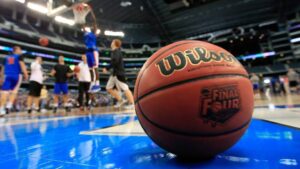by The Cowl Editor on March 16, 2017
Opinion

by Kevin Copp ’18
Opinion Staff
The excitement created by March Madness is normally unparalleled on many college campuses. At about 5 p.m. on Selection Sunday, every fan begins to dream of his or her team cutting down the nets.
While the tournament is open to teams from 32 different conferences from across the nation that play Division I basketball, the recent trends exhibited by the selection committee that chooses the teams for the tournament has kept many worthy teams in smaller conferences from entering the field.
The selection committee should focus more on picking the worthiest teams from all of the conferences and not merely rewarding bigger schools for playing in so-called major conferences.
There has been a significant shift in the committee’s thinking in the past 10 years. In the 2006 NCAA Tournament, the selection committee chose four teams from the Missouri Valley Conference, a conference made up of less well-known schools but still a largely successful league. That year, two schools from the Valley had highly successful runs to the Sweet Sixteen.
In 2017, however, the committee selected only one team from the Missouri Valley and passed over Illinois State, a deserving team that lost only six games all season. The RPI, an advanced metric that ranks teams based on statistical analysis, pegs Illinois State as the 33rd best team in the country (68 teams make the tournament).
Although the committee’s defense of excluding Illinois State focused on their playing a schedule filled with weak teams, schools like Illinois State have trouble finding good teams to play because the brand-name schools are afraid of losing a game to an opponent without a big name. Thus, schools like Illinois State are stuck playing mediocre competition for most of their season and then must rely solely on receiving the automatic bid to the tournament by being the champion of the Missouri Valley. When this does not happen, like this year, Illinois State is left on the outside looking in.
The biggest reason why mid-major schools like Illinois State have trouble cracking the field is because of the make-up of the committee itself. Members who are athletic directors from the major conferences have a financial incentive to reward teams from their own conferences. For example, committee chair Mark Hollis of Michigan State University has a bias to ensure as many teams from the Big Ten Conference enter the tournament because of increased exposure for the league and additional revenue down the line as a result of that exposure.
When the committee is only made up of 10 members, teams like Illinois State that do not have a representative from their conference on the committee lose the same opportunity that other schools have. Teams that have an average standing in their conference but have played enough difficult teams receive bids to the tournament often because the toss-up between two teams will always go to the more financially-viable option.
The nature of selection to the NCAA Tournament has become much more exclusive. Big-name schools that play in conferences with exorbitant TV deals often get bids because of the financial benefits for their conference and are rewarded for avoiding playing good teams from outside of the major conferences.
The selection committee needs to focus on selecting worthy at-large teams from mid-major conferences, or else the days of seeing teams like George Mason, Wichita State, and Butler make runs to the Final Four will soon be over.